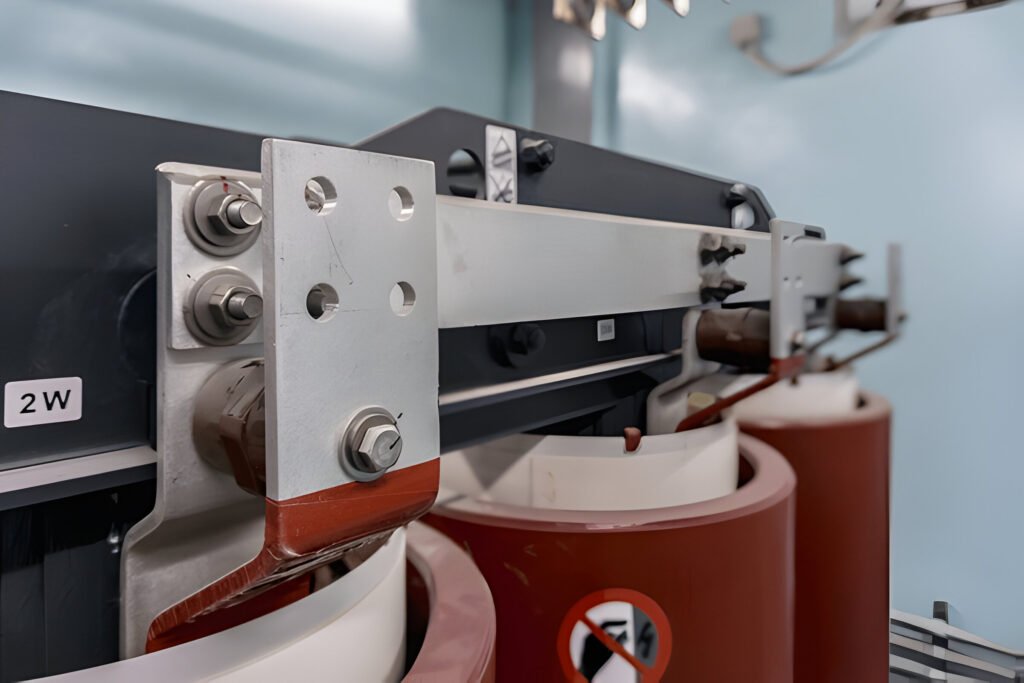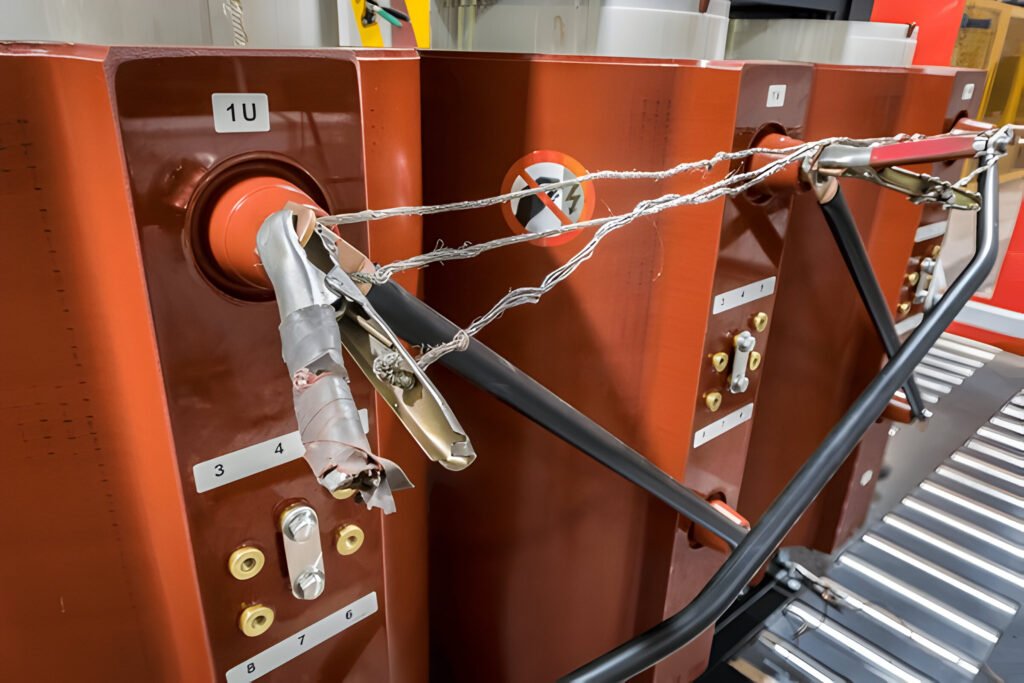What Are the Failure of Distribution Transformers
Distribution transformers can fail due to overloading, insulation breakdown, lightning strikes, or manufacturing defects.
Read More

Dry-type transformers are specialized electrical devices that use air instead of liquid for cooling, enhancing safety and reducing environmental concerns. They are crucial in powering commercial and industrial settings.
But how do they work, and when should you consider using one? Discover their growing popularity in modern electrical systems.
A dry-type transformer is designed to convert high voltage electricity to lower, more usable levels for commercial and industrial applications. Unlike oil-filled transformers, dry-type transformers utilize air circulation for cooling instead of liquid coolant, enhancing their safety and environmental friendliness.
Dry-type transformers function based on the principle of electromagnetic induction. When alternating current (AC) flows through the primary winding, it generates a fluctuating magnetic field within the transformer’s core. This dynamic field induces a voltage in the secondary winding, thus transferring electrical energy between the two coils without the need for a direct electrical connection.
Unlike their liquid-cooled counterparts, dry-type transformers utilize air or solid insulation. The core is typically composed of laminated silicon steel sheets, which minimize energy losses caused by eddy currents. The windings, made from either copper or aluminum, are wrapped around the core and insulated using materials such as epoxy resin or polyester.
The voltage ratio between the input and output is determined by the number of turns in each coil. By adjusting this ratio, the transformer can either step up or step down the voltage to meet specific requirements. Heat generated during operation is dissipated via convection and radiation.
Cast resin transformers are characterized by windings encapsulated in epoxy resin. This encapsulation provides superior protection against moisture, dust, and chemicals, making them ideal for harsh environments. Additionally, they offer high short-circuit strength, enhancing their reliability in demanding conditions.
VPI transformers utilize a vacuum pressure process to impregnate their windings with varnish. This method improves insulation and heat dissipation, making them cost-effective and suitable for indoor applications.
Open-wound transformers feature exposed windings, offering a basic yet economical solution. They are lightweight and provide good ventilation, but their exposed nature makes them more susceptible to environmental factors such as dust and moisture.
There are also specialty dry-type transformers designed for specific needs. K-factor transformers are optimized for non-linear loads, while harmonic mitigating transformers aim to reduce harmonic distortion in electrical systems. These specialized transformers address unique challenges in various industrial and commercial settings.
Indoor dry-type transformer enclosures are usually NEMA 1 or NEMA 2 rated. NEMA 1 enclosures offer basic protection against dust and accidental contact, suitable for general indoor use. NEMA 2 enclosures provide additional protection against falling dirt and light splashing water, making them ideal for more demanding indoor environments.
For outdoor applications, more robust enclosures are required. NEMA 3R enclosures are suitable for outdoor use, offering protection against rain, sleet, and snow. In more severe outdoor conditions, NEMA 4 enclosures provide watertight protection, while NEMA 4X enclosures offer both watertight and corrosion-resistant protection, essential for harsh environments.
In hazardous locations, specialized enclosures such as NEMA 7 and NEMA 9 are necessary. These enclosures are designed to contain internal explosions and prevent the ignition of flammable gases or dust in the surrounding environment, ensuring safety and compliance with stringent industry standards.

These transformers are inherently safer due to the absence of flammable liquids, thereby reducing the risk of fire and environmental contamination. Additionally, they are more environmentally friendly, as they eliminate the need for oil disposal and mitigate the potential for leaks.
The compact design and minimal maintenance requirements of dry-type transformers make them suitable for indoor installations and confined spaces. These transformers exhibit less sensitivity to load variations and tend to have a longer lifespan compared to liquid-filled types.
From a cost perspective, dry-type transformers are advantageous due to their lower installation costs and reduced need for frequent inspections. They are also more energy-efficient, leading to decreased operating expenses. Furthermore, their quieter operation makes them suitable for noise-sensitive environments.
These transformers are generally more expensive than their oil-filled counterparts, which can significantly impact the initial investment. Additionally, dry-type transformers exhibit a lower overload capacity, meaning they are less capable of handling sudden power surges compared to oil-filled models.
Size and weight are also concerns with dry-type transformers. They are typically larger and heavier than oil-filled transformers of equivalent capacity, posing challenges in installation and space requirements. Furthermore, dry-type transformers are more sensitive to environmental conditions such as humidity and dust, which can adversely affect their performance and lifespan.
Another critical disadvantage is the higher operating temperature of dry-type transformers. This characteristic can lead to increased energy losses and reduced efficiency. Moreover, they tend to produce more noise during operation, which can be problematic in noise-sensitive environments. The expected lifespan of dry-type transformers is generally shorter than that of oil-filled models, potentially increasing long-term costs.
Dry-type transformers are less suitable for outdoor installations without proper enclosures, limiting their versatility in certain applications.

These transformers are particularly advantageous in commercial buildings, hospitals, schools, and high-rise structures, where the absence of flammable liquids reduces fire hazards.
Dry-type transformers excel in offshore platforms, chemical plants, and food processing facilities due to their resistance to moisture-related issues. Their design also complies with stringent environmental regulations, making them suitable for projects where oil spills or leaks pose significant risks.
Dry-type transformers are preferable for these scenarios. They are well-suited for renewable energy projects like wind farms and solar installations. Additionally, these transformers are valuable in temporary power setups or mobile substations due to their portability.
The compact and lightweight design of dry-type transformers offers a practical solution compared to liquid-filled transformers, making them ideal for installations where space is at a premium.
IEEE C57.12.01 focuses on general requirements for dry-type distribution and power transformers. It covers aspects like insulation levels, temperature rise limits, and short-circuit withstand capabilities.
IEC 60076-11 is an international standard specifically for dry-type power transformers. It provides guidelines on electrical characteristics, thermal performance, and environmental considerations. This standard is particularly relevant if you are working in Europe or other regions that follow IEC standards.
Other important standards include NEMA ST 20, which covers construction and test requirements, and UL 1562, which applies to transformers used in hazardous locations.

Dry-type transformers use air and solid insulating materials, while oil-filled transformers rely on insulating oil.
Generally, dry-type transformers require less maintenance compared to oil-filled transformers, as they eliminate concerns related to oil leaks, regular oil testing, and oil replacement.
Dry-type transformers generally exhibit lower operational costs over their lifetime.
Dry-type transformers hold a clear advantage in terms of environmental impact and ease of recycling. These transformers do not contain oil, thus eliminating the risk of hazardous waste and the need for special handling during disposal. The primary components, such as copper windings and steel cores, are composed of materials that are easily recycled.
Dry-type transformers typically exhibit lower efficiency levels than oil-filled transformers, particularly under partial load conditions. This discrepancy arises from the higher core and winding losses inherent in dry-type transformers.
Dry-type transformers offer greater flexibility in installation locations. They are suitable for indoor settings, including buildings, underground vaults, and areas with limited ventilation.

Insulation class denotes the maximum temperature the insulation can endure without deteriorating. Common insulation classes include B (130°C), F (155°C), and H (180°C). Higher classes provide superior thermal resistance but come with increased costs.
Temperature rise ratings represent the allowable increase in temperature above ambient conditions during operation. Typical ratings are 80°C, 115°C, and 150°C. Lower temperature rises generally extend transformer life but necessitate larger, more expensive units. Conversely, higher temperature rises permit smaller, more economical transformers but may shorten their lifespan.
Typically, transformers achieve peak efficiency at 50-70% of their rated load, with efficiency declining at both lower and higher load levels.
When choosing a transformer, it is imperative to analyze its efficiency curve across the entire load range. Opt for units that sustain high efficiency over a broad spectrum of loads, particularly if your application involves fluctuating power demands. Additionally, consider the transformer’s no-load losses, which occur even when the transformer is idle but still connected to the power supply.
Energy efficiency standards, such as those mandated by the Department of Energy, often outline minimum efficiency levels at specific load points. Ensure that your selected transformer meets or exceeds these regulatory requirements.
The primary voltage rating must match your incoming power supply, while the secondary voltage rating should meet your load requirements.
Common primary voltage ratings for dry-type transformers include 480V, 600V, and 4160V. Secondary voltages are typically 120V, 208V, or 240V.
The kVA (kilovolt-ampere) rating indicates the transformer’s power capacity. To choose an appropriately sized transformer, calculate your total load requirements. Standard kVA ratings for dry-type distribution transformers range from 15 to 2500 kVA.
Avoid undersizing your transformer, as this can cause overheating and reduce its lifespan. Conversely, oversizing can lead to unnecessary costs and decreased efficiency at lower loads. When selecting the kVA rating, consider future load growth and peak demand. It is often advisable to choose a transformer with a capacity 20-30% higher than your current needs to accommodate potential expansion.
Indoor Enclosures:
Indoor transformers are designed for controlled environments. For indoor installations, you have two primary options: ventilated and sealed enclosures.
Outdoor Enclosures:
For outdoor installations, transformers must be equipped with weather-resistant enclosures. These are typically sealed to guard against moisture, dust, and other environmental hazards. Features such as special paint coatings, gasketed doors, and drain holes are often included to prevent water accumulation and enhance durability.

A dry-type distribution transformer typically lasts 20-30 years with proper maintenance.
Yes, dry-type transformers can be used outdoors if protected from the elements. They should be installed in weatherproof enclosures to shield from rain, snow, and extreme temperatures.
Perform maintenance on dry-type transformers annually, and more frequently in harsh environments. Inspect connections, clean ventilation, and test insulation resistance during each maintenance session.
Yes, dry-type transformers are more eco-friendly than oil-filled ones. They are safer, require less maintenance, and eliminate the risk of oil leaks. They are also easier to dispose of when decommissioned.
Dry-type transformers are usually quieter than oil-filled ones, with noise levels ranging from 45 to 65 decibels, based on size and load. They may still produce a low humming sound during operation.
Yes, dry type transformers can be installed without an enclosure in certain environments. They are suitable for indoor, dry, and clean locations with good ventilation. However, if the transformer is exposed to dust, dirt, moisture, or other contaminants, an enclosure is recommended to protect the transformer and ensure proper operation.